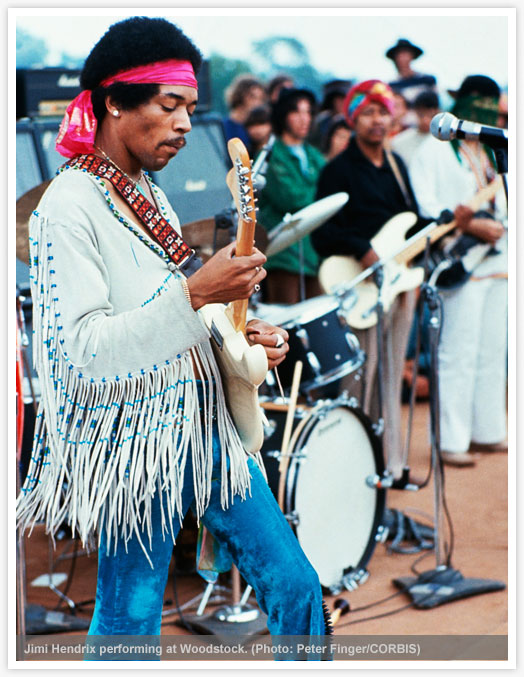
Happy Friday POU!
It is probably the epitome of irony that the most historic, iconic performances of the National Anthem, are performances by African-Americans.
“The moment when he played ‘The Star-Spangled Banner, kinda stopped everything.” – Henry Ditz, official photographer for Woodstock
Jimi Hendrix’s unorthodox Woodstock performance of America’s National Anthem, “The Star-Spangled Banner”, ignited controversy in August of 1969. Hendrix was originally scheduled to close out Woodstock on Sunday night, but he didn’t end up taking the stage until Monday morning, after most of the crowd had left. Still, his performance lived on through recordings and was heard and seen by both his fans and his detractors. It is considered by many to be the defining performance of Woodstock.
Hendrix used copious amounts of amplifier feedback, distortion, and sustain to replicate the sounds made by rockets and bombs. Many saw it as a protest against the Vietnam War. When Dick Cavett asked him about the controversy surrounding his anthem, Hendrix replied:
“I don’t know, man. All I did was play it. I’m American, so I played it. I used to sing it in school. They made me sing it in school, so it was a flashback.” Cavett interrupted the interview to point out to the audience, “This man was in the 101st Airborne, so when you send your nasty letters in …” Cavett then explained to Hendrix that whenever someone plays an “unorthodox” version of the anthem, “You immediately get a guaranteed percentage of hate mail.”
Hendrix then respectfully disagreed with Cavett’s description. “I didn’t think it was unorthodox,” he said. “I thought it was beautiful.”
Asked to look back at that time and that interview, Cavett’s memory was hazy. But after looking at the clip again, Cavett said: “I suppose I could have added that since we somehow acquired the most dismal, virtually unsingable dirge of a national anthem of any known nation, we should decorate Hendrix for turning it into music.”
Pop critic Al Aronowitz of The New York Post wrote: “It was the most electrifying moment of Woodstock, and it was probably the single greatest moment of the sixties.”
By the time of their set, Hendrix had been awake for more than three days. Upon leaving the stage, he collapsed from exhaustion.
Marvin Gaye, 1983 NBA All-Star Game

At the 1983 NBA All-Star Game, that Marvin Gaye stole the show with his singular rendition of “The Star-Spangled Banner.”
At the time, singing the anthem was for the most part a straightforward job — shoulders square, sing it straight like the hymn that it is. But for this game, Gaye took the anthem to a new level.
Few people realized that Gaye’s growing cocaine addiction was causing his life to spiral completely out of control. But no matter how bad things got offstage, he always managed to pull himself together when the spotlight hit. He looked like he didn’t have a care in the world when he walked onto the floor at The Forum in Inglewood, California, and delivered a spine-tingling rendition of “The Star-Spangled Banner.” He completely stripped it down, using little but his voice and a drum machine. but he managed to deliver one of the most beloved renditions of the song ever recorded.
Lon Rosen remembers it well — he was the director of promotions for the Los Angeles Lakers, the team hosting the All-Star game that year. He says Gaye’s one rehearsal was extremely shaky and organizers worried he’d blow it on the broadcast, by this point in his life, Gaye was battling a serious drug addiction. And on game day, the singer was running perilously late. But when he arrived, he looked like he didn’t have a care in the world when he walked onto the floor at The Forum in Inglewood, California, and delivered a spine-tingling rendition of “The Star-Spangled Banner.” He completely stripped it down, using little but his voice and a drum machine. but he managed to deliver one of the most beloved renditions of the song ever recorded. The lights dimmed, and Gaye made history. (continue)

